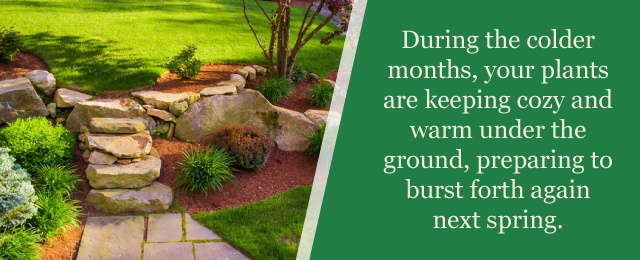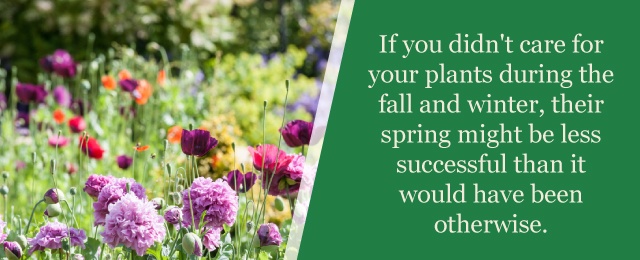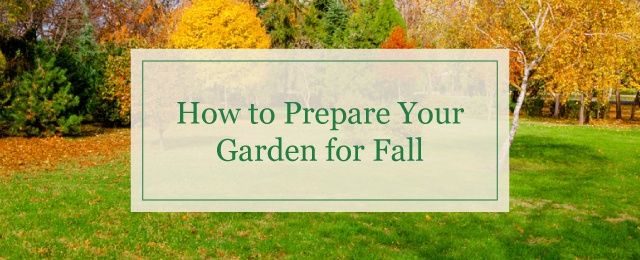Who doesn’t love the sight of their garden in the spring and summer? During these beautiful seasons, your garden is bursting with color and life, flowers and shrubs, bumblebees and sunshine.
Fall might not typically be a season we associate with beauty in the garden, but this season can be an amazing time for your garden as well. Even though this is typically the season when many of your summer plants begin to return to their dormant state, plenty of other plants are just starting to open up and enjoy the sunlight. Think of mums, asters, ornamental kale and more. There’s a lot to love about your garden in the autumn.
Of course, fall isn’t without its unique challenges. Because this season is characterized by so many plants shedding their blossoms and becoming dormant, it’s important to know how to care for your plants and your garden as a whole as it prepares to face the upcoming winter.
Since this season is full of difficulties that come with readying your garden for the fall, we want to make sure you’re ready. To help you out, we’ve pulled together this guide to fall garden preparation: what it is, why you can benefit from it and how you can get started with some simple steps today.
Ready? Let’s jump right in.
Why Prepare Your Garden for Fall?

While summer and spring are the seasons we most associate with gardens and gardening, fall and winter are just as crucial, if not more so, to making your garden beautiful. During these colder months, your plants are keeping cozy and warm under the ground, preparing to burst forth again next spring.
However, this isn’t always the case. It’s all too easy for things to go wrong during these critical months. If you haven’t put in the work it takes to keep your garden safe during the winter, plenty of things could go wrong. While you might not notice anything has happened at the time, it will become all too apparent when spring arrives and your plants fail to return for another year.
Preparing your garden for the fall isn’t just about preventing disasters in the spring, either. Sometimes it’s less life-or-death than that. Sometimes, the purpose of fall garden prep can be as simple as lightening your load in the following spring. If you don’t do any work in the fall, your garden may still be perfectly healthy in the spring. But you’re likely to find things have fallen into disarray, and it will take a lot more work to get your garden looking spick-and-span again. To save yourself this extra work in the spring, do a little prep before fall arrives.
Preparing Your Garden for Fall Benefits
In discussing why it’s essential to prepare your garden for the fall, we tangentially touched on just a few of the many benefits you’ll reap when you take time to prepare your garden for fall weather. Let’s look at these benefits in a little more depth now.
1. Protecting Your Plants From Harsh Weather
It’s an unfortunate truth that fall and winter are not always gentle on your plants. While some winters are less harsh than others, every cold season has the potential to damage your plants severely. Whether this damage comes from ice, snow, harsh winds or a combination of all three, don’t take these environmental factors lightly.
Through careful prep work for the fall season, however, you can ensure your plants are safe from these concerns. By working to keep your garden protected, you can be certain even if the damage does occur, it will be minimal enough that your plants will be able to make a full recovery the following spring.
2. Protecting Your Plants From Hungry Animals
Harsh weather isn’t the only danger your plants will face as they get ready to weather the cold season. Hungry animals are also a very real concern. During the fall and winter, almost all local vegetation hibernates until spring. For local wildlife like deer, rabbits, mice and more, food is scarce and difficult to find. If any of your plants remain above ground during this season, animals will see them as a source of tasty, free dinners.
By taking measures to prepare your garden for the fall, you can work to minimize or even eliminate the damage animals can do to your plants. Whether this damage comes from animals digging in your garden or nibbling at bare stems and trunks, fall prep work can help keep these plant injuries from being too severe.
3. Giving Your Plants a Jumpstart on Spring

Spring is the season when your plants are busy waking up and starting to grow again. This is hard work, and it takes lots of sunlight, water and nutrients to make it happen. If you didn’t care for your plants during the fall and winter, however, their spring might be less successful than it would have been otherwise. That’s because they have to work twice as hard — not only do they have to do the work of waking up and growing, but they also have to repair themselves from the damage they suffered over the winter.
Think of it as you might think of a person sleeping. Fall represents getting ready for bed, winter represents sleeping and spring is the morning, when you get up and begin to face the day. If someone kept waking you up all night, you wouldn’t feel quite as chipper in the morning as you might have otherwise. While this analogy isn’t perfect, it helps us understand why plants need a successful hibernation period to perform well in the spring.
4. Saving Yourself Some Work
Fall and winter can wreak havoc in your garden if you aren’t careful. Stems and branches can snap, entire root systems can get torn up, animals can nibble every visible bit of greenery —and dig holes, while they’re at it — and ice can cause bark to crack wide open.
These are preventable concerns, however. With a little forethought, patience and the right supplies, none of these have to happen. On the other hand, if you don’t perform any prep work, a few of these concerns are likely to occur, and you’ll have to spend your spring season putting your garden back together. Why not save yourself this extra work by making some meaningful preparations beforehand?
You might reason you’d rather do the work in the spring, with the rest of your yard work. We recommend against this, however. Your garden will thank you, and it will come out in the spring looking all the more beautiful thanks to your efforts.
How to Prepare Your Garden for Fall Weather
Now that we know a bit more about why it’s important to get your garden ready to face the colder weather, let’s get down to the practical details. What are some concrete changes you can make to your garden to better prepare it this fall?
1. Fertilize

Before you do your fall tilling, it’s worth it to spend a little bit of time fertilizing your garden. Invest in nutritional plant food for your garden, manure or some other type of biological material that will provide your garden with nutrients and minerals all winter long. Spread this out over the soil in an even layer and then do your tilling. The tilling process will help mix this material into your soil, where it will do wonders for your garden’s health.
2. Till the Soil
This advice may not apply to every type of garden, but if you have a vegetable garden, it will certainly be relevant to you. While almost everyone knows to till their garden in the spring, all too many people forget about the importance of tilling their soil in the fall.
When you till your garden in the fall, it aerates the soil earlier, allowing oxygen to reach farther down into the earth. The organic matter can fertilize the soil better, and the remnants of this summer’s garden will better break down and reduce into their basic organic components. In turn, this will help give your garden a healthy jumpstart on the next spring.
If you only till your soil in the spring, the earth will only have a month or so to let the nutrients soak in. By doing this in the fall, you give the earth a whole season to become rich and revitalized.
3. Dig up Weeds
Often, it isn’t enough to merely clip the tops off the weeds in your garden. When you cut the tops off, the roots can still thrive — underground and unseen. While harsh winter weather will sometimes kill these roots off, they can also survive. If they do weather the winter, they will return with a vengeance in the spring. Not only will they be back, but they’ll also have a larger root system that makes them more difficult to pull up.
Solve this problem by digging up the roots in the fall. While it may be impractical to dig up the root system of every weed, depending on the size of your garden, it’s certainly worth it to give your attention to your most stubborn roots. Pass over the small weeds like clover, and attack your most resilient weeds — the ones that just keep coming back. Make sure you get all the roots, as well as any seeds that may have dropped. By doing this, you’ll help prevent these weeds from returning and giving you more headaches next year.
4. Add Extra Mulch
Over the course of the summer, it’s all too easy for mulch to get kicked around and displaced. Whether this is from rain, wind, animals or your feet, it happens and is completely understandable. Fall is the perfect time to check how your mulch is doing and add more where necessary.
By adding extra mulch and filling in the bare spots, you’re helping insulate the roots deep in the earth, keeping them warm against the upcoming weather. Also, you’re setting up a barrier that will help prevent animals from digging in your garden for food.
5. Check for Disease
Fall is the perfect season to check for diseases or maladies of any kind in your garden. Check for bug problems, infestations, illnesses or any of the other many things that can infect a garden. That means examining leaves, bark, stems and everything else, looking for mysterious spots, discolorations and limp, unhealthy-looking plants. By catching these issues in the fall, you can prevent them from festering all winter and returning next spring.
6. Remove Unhealthy Plants
If you notice plants that have died in the course of tidying things up, this is the perfect time to dig those up and remove them. In some cases, this won’t be an entire plant. Maybe it’ll only be part of a plant that’s died, or is looking like it will soon. Don’t be afraid to cut this part off and remove it altogether. Pull it out and throw it in the compost heap.
7. Bring Things Indoors
Do you have any plants outdoors that aren’t hardy enough to last the winter? If so, you’ll need to bring them indoors. That might mean digging up bulbs and storing them in your garage or basement, in which case you need to get started before the earth begins to get too cold in the fall. It might also be as simple as bringing in potted plants that have been decorating your front porch. Let these delicate beauties spend the winter indoors, and they’ll fare better.
8. Give a Little TLC
To prep your garden for the fall, you’ll need to spend a fair amount of time out there doing basic chores that will help get your plants ready for colder weather. That means things like trimming off dead sections of your plants, replacing cheap ties with sturdy jute twine for the winter and brushing mulch off your plants itself, as it can cause damage over time. In short, get your garden looking shipshape all around.
9. Dig Up Annuals
Annuals only last for one season. At the end of the summer, the blooms have faded and the plant systems are dying off. Because they won’t return in the spring, there’s no point in allowing them to stay in the ground. As you complete your other fall chores, be sure to pull these spent plants up and throw them in your compost pile.
10. Don’t Forget About Your Lawn
It’s important to take care of your garden in the fall, but you don’t want to be so focused on your garden that you forget about your lawn. It needs your care and attention as well. Here are a few the things you can do to prep your lawn for the fall.
- Keep mowing: By not allowing the grass to grow too long, you’re helping the sunlight reach the roots of the grass, thus keeping it healthier.
- Rake the leaves: Raking might not be your favorite activity, but it can do wonders for your lawn. It helps the grass get more oxygen, prevents it from suffocating and prevents the spread of unhealthy fungus.
- Seed the bald spots: Fall is the best season for noticing bald or sparse patches in your lawn. Carefully fill these in with a lawn seed mixture of your choice and let these seeds germinate all winter.
- Aerate the soil: As you aerate garden dirt, don’t forget your lawn. Do this yourself with an aerator that will punch tiny holes in the ground, or hire a contractor.
Visit Patuxent Nursery and Talk to a Plant Expert Today
If you’re facing some challenges in your fall garden preparations, don’t feel like you have to go it alone. If you live in or near Bowie, Md., swing by Patuxent Nursery and chat with our resident plant experts. We’d be happy to help you work through whatever difficulties you might be having and brainstorm solutions with you.
While you’re here, you can also browse our selection of tools, mulch, fertilizers and other items that will help you get your garden ready for the off-season. We hope to see you soon.


Leave a Comment
You must be logged in to post a comment.